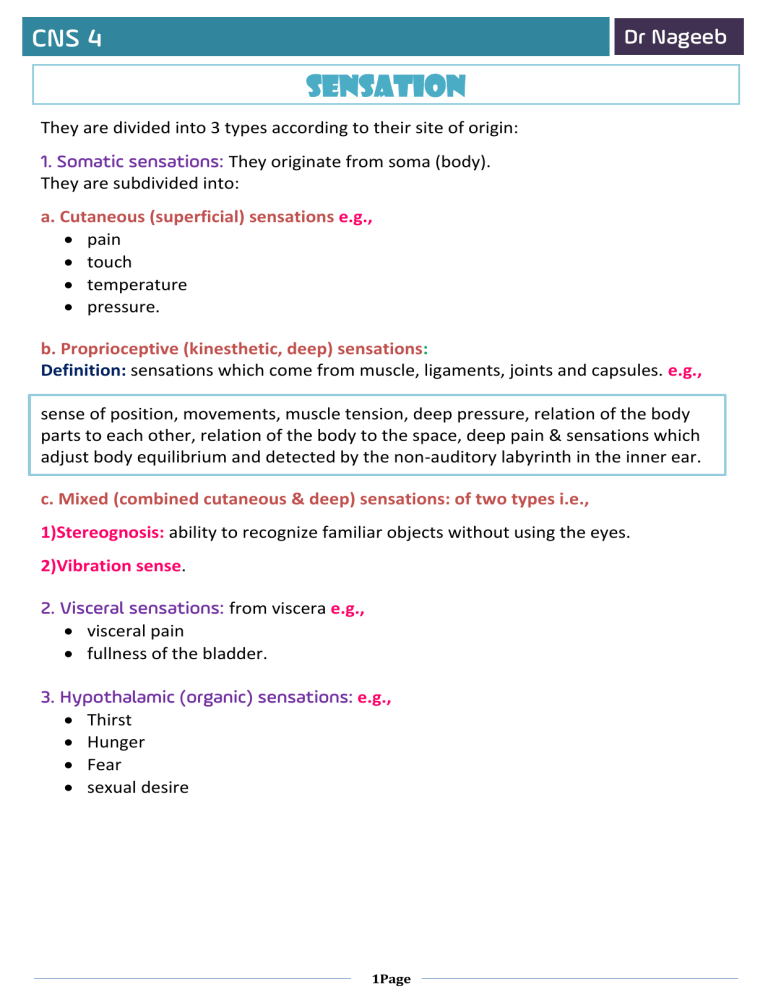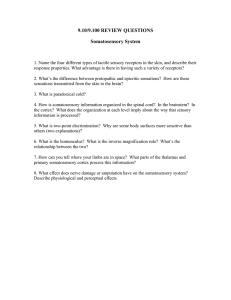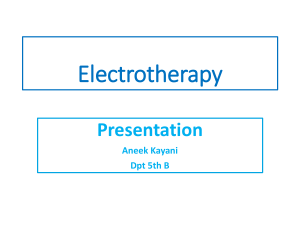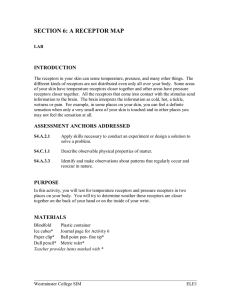
CNS 4 Dr Nageeb Sensation They are divided into 3 types according to their site of origin: 1. Somatic sensations: They originate from soma (body). They are subdivided into: a. Cutaneous (superficial) sensations e.g., pain touch temperature pressure. b. Proprioceptive (kinesthetic, deep) sensations: Definition: sensations which come from muscle, ligaments, joints and capsules. e.g., sense of position, movements, muscle tension, deep pressure, relation of the body parts to each other, relation of the body to the space, deep pain & sensations which adjust body equilibrium and detected by the non-auditory labyrinth in the inner ear. c. Mixed (combined cutaneous & deep) sensations: of two types i.e., 1)Stereognosis: ability to recognize familiar objects without using the eyes. 2)Vibration sense. 2. Visceral sensations: from viscera e.g., visceral pain fullness of the bladder. 3. Hypothalamic (organic) sensations: e.g., Thirst Hunger Fear sexual desire 1Page CNS 4 Dr Nageeb Cutaneous Touch Sensation Types of touch receptors: Pacinian corpuscle Free nerve ending Merkels disc "Iggo dome receptor" Hair end organ Spray type ending Meissner's corpuscle Ruffini's corpuscle Rapid adapting: Hair end organ & Pacinian corpuscle & Meissnere's corpuscle. Slowly adapting: Spray type ending. - Touch receptors are mechanoreceptors and can also detect vibration & pressure. Types of touch sensations: A. Crude (rough) touch B. Fine touch Poorly localized. Well localized. Transmitted by A delta (A δ) fibers. Transmitted by A beta (A β) fibers. 1-5 µ, 5-15 m/sec (8 -15 µ) and velocity of 30-60 m/sec Free nerve ending Merkel Hair end organ Meissner Basket hair endings Ventral spino thalamic tract gracile and cuneate tracts Types of fine touch: 1) Tactile localization (Topo-gnosis): - It is the ability of closed eye person to determine the site of previously touched point on skin. 2Page CNS 4 Dr Nageeb 2) Tactile discrimination (Two point discrimination): Definition: It is the ability of closed eye person to differentiate between touch in one point or simultaneous touch in two separate points. Threshold and sensitivity: - It is most accurate in the tips of fingers & lips (2 piont threshold = 2 mm). - It is less accurate in the back (2 piont threshold = 15 mm). Requirements: Part of body with very sensitive tactile discrimination must has: a) Very Crowded receptors. b) Many sensory nerves carry sensation. (NO Convergence). c) Wide area of representation is sensory Cortex. - Thus, each point touched reaches the spinal cord in a separate nerve fiber and reaches sensory cortex in a separate point. - Point to point discrimination is most accurate in retina (in fovea centralis). 3Page CNS 4 Dr Nageeb Cutaneous Temperature Sensation Types of thermoreceptors: A. Superficial receptors in skin: they are free nerve endings. Sensation Stimulus Receptors Afferent Warm 30 °C - 45 °C Free nerve endings "C" fibers Pain warm Above 45 °C Nociceptive Cold 10 °C - 30 °C Krause end bulb "Aδ" fibers Pain cold Below 10 °C Nociceptive B. Deep receptors in hypothalamus: detect body temperature from blood. Mode of stimulation of thermoreceptors: - Thermoreceptors are stimulated by change in their metabolic activity. - They are strongly stimulated during rapid change in temperature than constant temperature - Moderately adapting between 20 40 C below or above no adaptation - Tissue damage begins to occur below 10°C & above 45°C which is described as pain sensation - At 0°C, no action potential is recorded from thermoreceptors Paradoxical cold sensation: - On taking hot shower at 45 °C, we 1st feel cold (shivering) followed by warm sensation. - This is because cold receptors are: a) 10 Times More numerous than warm receptors & More superficial. b) Momentary discharge at 45°C. Temperature pathway: the same pathway as immediate pain ( lateral spinothalamic tract ) 4Page CNS 4 Dr Nageeb Proprioceptive (Kinesthetic, Deep) Sensations Types of proprioception: sense of position, movements, deep pressure, muscle tension, relation of parts of body to each other and to the space. It may be - conscious (reaches sensory cortex) - unconscious (doesn’t reach sensory cortex). Proprioceptors: are either slowly adapting receptors (Golgi tendon organ and muscle spindle spray type ending) rapidly adapting receptors (Pacinian corpuscles). 1. Conscious proprioceptive sensation: They are carried by the rapid dorsal column system to the sensory cortex. (Gracile and Cuneate tracts): 2. Unconscious proprioceptive sensation: joint and muscle movements during walking running swimming. They are carried by: a. Dorsal (direct) and ventral (indirect) spino-cerebellar tracts: b. Spino-reticular and spino-olivary tracts: most of them do not reach the sensory cortex, but they are coordinated by cerebellum, basal ganglia and other nuclei in brainstem like reticular formation and vestibular nuclei. 5Page CNS 4 Dr Nageeb Mixed combined sensation - Pathway of mixed sensation : a) From upper limbs: by rapidly conducting cuneate tract. b) From lower limbs: by rapidly conducting gracile tract. c) From face: by trigeminal nerve (cranial nerve V). 1- Stereo gnosis: (Stereo = 3 dimension & Gnosis = recognition) Definition: It is the ability of closed eye person to recognize the previously educated familiar objects present in palms of the hand. Requirements: This type of fine touch needs both cutaneous & deep receptors. Pathway: Cuneate tract of dorsal column (carry fine touch from upper limbs). Center: It reaches to certain area in brain (area 5,7 of cerebral cortex). Causes of Astereognosis (loss of stereognosis): 1. 2. 3. 4. 5. 6. Syphilis tabes dorsalis which destroy the dorsal roots (Afferent). Pernicious anemia ( vit B12) demyelination of nerves. Peripheral neuritis as in diabetes mellitus. Cutting of Cuneate tract which carry fine touch from upper limbs. Lesion in the sensory Cortex (area 5,7 of cerebral cortex). Damage of thalamus (thalamic syndrome). 2- Vibration sense: - It is repeated tactile stimulation. - It needs Both cutaneous & deep receptors. - Bone itself does contain receptors for vibration sense, and vibration can be felt on soft tissues. - Receptors of vibration: a) Meissners corpuscles respond to vibration of 80 Hz. b) Pacinian corpuscles respond to vibration of 500 Hz. 6Page CNS 4 Dr Nageeb The dermatomes - Definition: areas of the skin which are supplied by the same dorsal root. - There is a known map of the body for the dermatomal distribution. - There is considerable overlap between adjacent dermatomes i.e. cutting of one dorsal root dose not lead to complete loss of sensations from area supplied with it. - Each dorsal root carries sensation from certain area of skin, part of viscera and part from deep structures - Importance of the dermatomal distribution: 1) To know level of lesion in spinal cord. It enables us to know the segment which is affected in the spinal cord lesion and in other neurological diseases. 2) Referred pain phenomenon. 7Page







